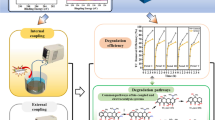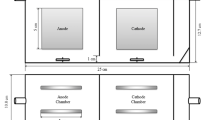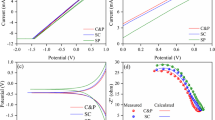Abstract
In this study, nickel–cobalt co-modified stainless steel mesh (Ni-Co@SSM) was prepared and used as the biocathode in microbial electrolysis cell (MEC) for sulfamethazine (SMT) degradation. The optimal electrochemical performance of the Ni-Co@SSM was obtained at the electrodeposition time of 600 s, electrodeposition current density of 20 mA cm−2, and nickel–cobalt molar ratio of 1:2. The removal of SMT in MEC with the Ni-Co@SSM biocathode (MEC-Ni-Co@SSM) was 82%, which increased by 30% compared with the conventional anaerobic reactor. Thirteen intermediates were identified and the potential degradation pathways of SMT were proposed. Proteobacteria, Firmicutes, Patescibacteria, Chloroflexi, Bacteroidetes, and Euryarchaeota are the dominant bacteria at the phylum level in the MEC-Ni-Co@SSM, which are responsible for SMT metabolism. Due to the electrical stimulation, there was an increase in the abundance of the metabolic function and the genetic information processing. This work provides valuable insight into utilizing MECs for effective treatment of antibiotic-containing wastewater.







Similar content being viewed by others
Data Availability
Data will be made available on request.
References
Agrahari R, Bayar B, Abubackar HN, Giri BS, Rene ER, Rani R (2022) Advances in the development of electrode materials for improving the reactor kinetics in microbial fuel cells. Chemosphere 290:133184
Al Mohamad D, Goeman JJ, van Zwet EW (2022) Simultaneous confidence intervals for ranks with application to ranking institutions. Biometrics 78:238–247
Basak B, Patil SM, Kumar R, Ahn Y, Ha G-S, Park Y-K, Ali Khan M, Jin Chung W, Woong Chang S, Jeon B-H (2022) Syntrophic bacteria- and Methanosarcina-rich acclimatized microbiota with better carbohydrate metabolism enhances biomethanation of fractionated lignocellulosic biocomponents. Bioresour Technol 360:127602
Bora A, Mohanrasu K, Angelin Swetha T, Ananthi V, Sindhu R, Chi NTL, Pugazhendhi A, Arun A, Mathimani T (2022) Microbial electrolysis cell (MEC): reactor configurations, recent advances and strategies in biohydrogen production. Fuel 328:125269
Boxall ABA, Blackwell P, Cavallo R, Kay P, Tolls J (2002) The sorption and transport of a sulphonamide antibiotic in soil systems. Toxicol Lett 131:19–28
Cai P, Zhao J, Zhang X, Zhang T, Yin G, Chen S, Dong C-L, Huang Y-C, Sun Y, Yang D, Xing B (2022) Synergy between cobalt and nickel on NiCo2O4 nanosheets promotes peroxymonosulfate activation for efficient norfloxacin degradation. Appl Catal b: Environ 306:121091
Caicedo HH, Hashimoto DA, Caicedo JC, Pentland A, Pisano GP (2020) PICRUSt2 for prediction of metagenome functions. Nat Biotechnol 38:669–673
Cao L, Zhang J, Zhao R, Deng Y, Liu J, Fu W, Lei Y, Zhang T, Li X, Li B (2019) Genomic characterization, kinetics, and pathways of sulfamethazine biodegradation by Paenarthrobacter sp. A01. Environ Int 131:104961
Chen J, Zhou X, Zhang Y, Gao H (2012) Potential toxicity of sulfanilamide antibiotic: binding of sulfamethazine to human serum albumin. Sci Total Environ 432:269–274
Cui Y, Lin J, Xu Y, Li Q, Chen Y, Ding L (2021) Hydrophilic crosslinking agent-incorporated magnetic imprinted materials with enhanced selectivity for sulfamethazine adsorption. Sep Purif Technol 276:119302
De Liguoro M, Fioretto B, Poltronieri C, Gallina G (2009) The toxicity of sulfamethazine to Daphnia magna and its additivity to other veterinary sulfonamides and trimethoprim. Chemosphere 75:1519–1524
Fan Y, Ji Y, Kong D, Lu J, Zhou Q (2015) Kinetic and mechanistic investigations of the degradation of sulfamethazine in heat-activated persulfate oxidation process. J Hazard Mater 300:39–47
Gao Y, Kong X, Zhou A, Yue X, Luo Y, Defemur Z (2020) Enhanced degradation of quinoline by coupling microbial electrolysis cell with anaerobic digestion simultaneous. Bioresour Technol 306:123077
Gautam R, Nayak JK, Ress NV, Steinberger-Wilckens R, Ghosh UK (2023) Bio-hydrogen production through microbial electrolysis cell: structural components and influencing factors. Chem Eng J 455:140535
Geetanjali DSK, Kundu PP (2022) Development of polypyrrole nanotube coated with chitosan and nickel oxide as a biocompatible anode to enhance the power generation in microbial fuel cell. J Power Sources 539:231595
Hemdan BA, Jadhav DA, Dutta A, Goswami P (2023) Facilitating the electrochemical characterization and biofilm enrichment through anode modification in microbial fuel cells. J Water Process Eng 54:104065
Hou L, Yin G, Liu M, Zhou J, Zheng Y, Gao J, Zong H, Yang Y, Gao L, Tong C (2014) Effects of sulfamethazine on denitrification and the associated N2O release in estuarine and coastal sediments. Environ Sci Technol 49:326–333
Hou H, Duan L, Zhou B, Tian Y, Wei J, Qian F (2020) The performance and degradation mechanism of sulfamethazine from wastewater using IFAS-MBR. Chinese Chem Lett 31:543–546
Li J, Xu M, Yao G, Lai B (2018) Enhancement of the degradation of atrazine through CoFe2O4 activated peroxymonosulfate (PMS) process: kinetic, degradation intermediates, and toxicity evaluation. Chem Eng J 348:1012–1024
Li J, Li A, Li Y, Cai M, Luo G, Wu Y, Tian Y, Xing L, Zhang Q (2021a) PICRUSt2 functionally predicts organic compounds degradation and sulfate reduction pathways in an acidogenic bioreactor. Front Environ Sci Eng 16:47
Li Y, Dong H, Li L, Xiao J, Xiao S, Jin Z (2021b) Efficient degradation of sulfamethazine via activation of percarbonate by chalcopyrite. Water Res 202:117451
Li Y, Qi J, Shen J, Yan P, Kang J, Wang B, Wang S, Zuo J, Chen Z (2022) Interface mechanism of peroxymonosulfate activation by cobalt-copper-ferrite nanoparticles mediated by palygorskite for bisphenol S degradation: a dual-path activation mechanism. Chem Eng J 448:137609
Liu X, Yang H, Chang J, Bai Y, Shi L, Su B, Han J, Liang D (2022) Re-hydrolysis characteristics of alkaline fermentation liquid from waste activated sludge: feasibility as a carbon source for nitrogen removal. Process Saf Environ 165:230–240
Luo R, Li Y, Xing L, Zhong R, Qian Z, Yin G, Wang Y, Du L (2022) A dynamic Ni(OH)2-NiOOH/NiFeP heterojunction enabling high-performance E-upgrading of hydroxymethylfurfural. Appl Catal b: Environ 311:121357
Mulla SI, Bagewadi ZK, Faniband B, Bilal M, Chae J-C, Bankole PO, Saratale GD, Bhargava RN, Gurumurthy DM (2023) Various strategies applied for the removal of emerging micropollutant sulfamethazine: a systematic review. Environ Sci Pollut Res 30:71599–71613
Ochiai I, Harada T, Jomori S, Kouzuma A, Watanabe K (2023) Bioaugmentation of microbial electrolysis cells with Geobacter sulfurreducens YM18 for enhanced hydrogen production from starch. Bioresour Technol 386:129508
Ovung A, Bhattacharyya J (2021) Sulfonamide drugs: structure, antibacterial property, toxicity, and biophysical interactions. Biophys Rev 13:259–272
Ovung A, Bhattacharyya J (2022) Binding effects of antibiotic drug sulfamethazine on the serum albumins: multi-spectroscopic and computation approach. Chem Phys Impact 5:100087
Ovung A, Mavani A, Ghosh A, Chatterjee S, Das A, Suresh Kumar G, Ray D, Aswal VK, Bhattacharyya J (2022) Heme Protein binding of sulfonamide compounds: a correlation study by spectroscopic, calorimetric, and computational methods. ACS Omega 7:4932–4944
Qiu L, Wu J, Qian Y, Nafees M, Zhang J, Du W, Yin Y, Guo H (2021) Impact of biochar-induced vertical mobilization of dissolved organic matter, sulfamethazine and antibiotic resistance genes variation in a soil-plant system. J Hazard Mater 417:126022
Ruiz-Uriguen M, Shuai W, Huang S, Jaffe PR (2022) Biodegradation of PFOA in microbial electrolysis cells by Acidimicrobiaceae sp. strain A6. Chemosphere 292:133506.
San-Martin MI, Escapa A, Alonso RM, Canle M, Moran A (2020) Degradation of 2-mercaptobenzothizaole in microbial electrolysis cells: intermediates, toxicity, and microbial communities. Sci Total Environ 733:139155
Saratale RG, Cho SK, Saratale GD, Ghodake GS, Bharagava RN, Kim DS, Nair S, Shin HS (2021) Efficient bioconversion of sugarcane bagasse into polyhydroxybutyrate (PHB) by Lysinibacillus sp. and its characterization. Bioresour Technol 324:124673
Shi K, Cheng W, Jiang Q, Xue J, Qiao Y, Cheng D (2022) Insight of the bio-cathode biofilm construction in microbial electrolysis cell dealing with sulfate-containing wastewater. Bioresour Technol 361:127695
Song Z, Zhuang H, Xiao Z, Suo D (2021) Residue accumulation, distribution, and withdrawal period of sulfamethazine and N-acetylsulfamethazine in poultry waste from broilers. Chemosphere 278:130420
Srivastava P, González C, Palma J, Garcia-Quismondo E (2023) Nanoporous oxide coating on carbon paper electrodes to enable bio-hydrogen production in microbial electrolysis cells. Catal Today 422:114246
Tačić A, Nikolić V, Nikolić L, Savić I (2017) Antimicrobial Sulfonamide Drugs Adv Technologies 6:58–71
Thapa BS, Kim T, Pandit S, Song YE, Afsharian YP, Rahimnejad M, Kim JR, Oh S-E (2022) Overview of electroactive microorganisms and electron transfer mechanisms in microbial electrochemistry. Bioresour Technol 347:126579
Wang G, Li Q, Li Y, Xing Y, Yao G, Liu Y, Chen R, Wang XC (2020) Redox-active biochar facilitates potential electron tranfer between syntrophic partners to enhance anaerobic digestion under high organic loading rate. Bioresour Technol 298:122524
Wang H, Chen N, Feng C, Deng Y (2021) Insights into heterotrophic denitrification diversity in wastewater treatment systems: progress and future prospects based on different carbon sources. Sci Total Environ 780:146521
Wang N, Feng Y, Li YZ, L, Liu J, Li N, He W, (2022) Effects of ammonia on electrochemical active biofilm in microbial electrolysis cells for synthetic swine wastewater treatment. Water Res 219:118570
Xu L, Li W, Luo J, Chen L, He K, Ma D, Lv S, Xing D (2023) Carbon-based materials as highly efficient catalysts for the hydrogen evolution reaction in microbial electrolysis cells: mechanisms, methods, and perspectives. Chem Eng J 471:144670
Yin R, Guo W, Wang H, Du J, Zhou X, Wu Q, Zheng H, Chang J, Ren N (2018) Enhanced peroxymonosulfate activation for sulfamethazine degradation by ultrasound irradiation: performances and mechanisms. Chem Eng J 335:145–153
Ying Z, Yu Y, Chen H, Zhao J, You J, Ye J, Hu J, Zhang S (2023) Structural characteristics and functional genes of biofilms in microbial electrolysis cells for chlorobenzene abatement. ACS ES&T Water 3:500–509
Zhang Y, Cao L, Fu H, Zhang M, Meng J, Althakafy JT, Abo-Dief HM, El-Bahy SM, Zhang Y, Wei H, Xu BB, Guo Z (2022) Effect of sulfamethazine on anaerobic digestion of manure mediated by biochar. Chemosphere 306:135567
Zhao Y, An H, Dong G, Feng J, Wei T, Ren Y, Ma J (2020) Oxygen vacancies induced heterogeneous catalysis of peroxymonosulfate by Ni-doped AgFeO2 materials: evolution of reactive oxygen species and mechanism. Chem Eng J 388:124371
Zhao J, Luan Y, Chen Y, Cheng L, Qin Q (2022) Toxicological and transcriptomic-based analysis of monensin and sulfamethazine co-exposure on male SD rats. Ecotoxicol Environ Saf 245:114110
Zhao X, Li X, Xu Y, Qi Y, Wei Q, Jia X (2023) Effects of Fe-Co@N-BC anode on degradation of sulfamethoxazole (SMX) in microbial fuel cells. J Water Process Eng 52:103569
Zhou Q, Bian Q, Liao L, Yu F, Li D, Tang D, Zhou H (2023) In situ electrochemical dehydrogenation of ultrathin Co(OH)2 nanosheets for enhanced hydrogen evolution. Chinese Chem Lett 34:107248
Zhu J, Liu S, Wang H, Wang D, Zhu Y, Wang J, He Y, Zheng Q, Zhan X (2022) Microplastic particles alter wheat rhizosphere soil microbial community composition and function. J Hazard Mater 436:129176
Zhuang S, Chen R, Liu Y, Wang J (2020) Magnetic COFs for the adsorptive removal of diclofenac and sulfamethazine from aqueous solution: adsorption kinetics, isotherms study and DFT calculation. J Hazard Mater 385:121596
Funding
This work was supported by the National Natural Science Foundation of China (Grant No. 22166023), the Industrial Support Plan Project of Colleges and Universities in Gansu Province (Grant No. 2023CYZC-30), the Talents Innovation and Entrepreneurship Project of Lanzhou (Grant No. 2021-RC-20), and the National Key Research and Development Innovative methods work special Program of China (SQ2020IM030400).
Author information
Authors and Affiliations
Contributions
All authors contributed to the study conception and design. Yabin Li: data curation, software, writing—original draft and editing. Qian Wei: investigation, methodology, formal analysis, validation, writing—original draft. Xia Zhao: conceptualization, resource, funding acquisition, project administration, writing—review and editing. Yihan Qi: investigation, supervision. Menghan Guo: methodology, software. Weijing Liu: resource, investigation. All authors read and approved the final manuscript.
Corresponding author
Ethics declarations
Ethics approval
Not applicable.
Consent to participate
None of the authors has any objection to participating in the study.
Consent for publication
None of the authors has any objection to publishing the data in the journal.
Competing interests
The authors declare no competing interests.
Additional information
Responsible Editor: Angeles Blanco
Publisher's Note
Springer Nature remains neutral with regard to jurisdictional claims in published maps and institutional affiliations.
Rights and permissions
Springer Nature or its licensor (e.g. a society or other partner) holds exclusive rights to this article under a publishing agreement with the author(s) or other rightsholder(s); author self-archiving of the accepted manuscript version of this article is solely governed by the terms of such publishing agreement and applicable law.
About this article
Cite this article
Li, Y., Wei, Q., Zhao, X. et al. Degradation of sulfamethazine by microbial electrolysis cell with nickel–cobalt co-modified biocathode. Environ Sci Pollut Res 31, 16497–16510 (2024). https://doi.org/10.1007/s11356-024-32313-1
Received:
Accepted:
Published:
Issue Date:
DOI: https://doi.org/10.1007/s11356-024-32313-1




